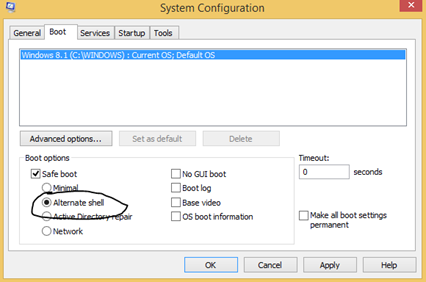When your computer is unable to start correctly, you need to use Safe Mode with Networking and try to figure out why it's not running what it should. That's why I'm going to show you how to turn on Safe Mode in Windows.

Safe mode in Windows is a fall-prevention troubleshooting process to repair various technical issues. Whenever something messes up your operating system, Windows's safe mode is your quick go-to in order to isolate your programs from unsafe component.
Most people prefer to run their programs in safe mode so that the operating system will only run the essential program components needed in a particular program. This can prevent your computer from experiencing software issues that inhibit software applications from installing effectively and correctly.
If you aren't familiar with performing this task, then this guide is for you. To know how you can run programs in safe mode, refer to the following steps.
For Windows 8
Refer to either of these two methods to run your program in safe mode on your Windows 8 device.
Method 1:
- Hold the Shift button on your keyboard and click Restart simultaneously.
- Then, a window will display on your screen with 3 options. Select Troubleshoot.
- Select Advanced Options.
- Click Startup Setting.
- After that, you will be able to see a list of options. You will find Restart in your screen's lower right corner.
- Choose the digit that corresponds to enabling Safe Mode.
Method 2:
- Hold the Windows button on your keyboard while pressing R.
- A dialogue box will appear.

- In that dialogue box, type the word ‘msconfig‘. Then, click OK.
- Go to the Boot window tab.
- Click Alternate Shell.

- Then, click Apply.
- Hit Ok.
- After that, you should restart your computer.
Do note that in order to exit from the command prompt in this version, you must type the word ‘msconfig‘ and hit enter.
For Windows 10
Before you try to troubleshoot system errors and complex technical issues, you must consider installing the latest updates of Windows 10. Installing Windows 10 updates will keep your computer away from conflicting applications, infections, and drivers.
This can spare you a significant amount of time and effort running particular software in safe mode. Once you have applied the latest updates already, follow the steps below:
Method 1:
- Hold Shift while you click Restart.
- Doing this will cause your computer to restart and you will be given options to choose from. Click on Troubleshoot.
- Once the Troubleshoot window displays on your screen, find Advanced Options and click it.
- Next, click Startup Settings.
- Select Restart.
- For you to be able to activate Safe Mode using the command prompt, hit F6.
Method 2:
- Shut down your computer.
- Turn it on again through the Power button.
- Repeatedly press the Power key if you see a circle spinning in the Boot Screen. This particular action will stop the usual Boot method and force the operating system to interrupt with the Repair mode.
- Choose Advanced Options. This can be found in the Startup window.
- Click on Troubleshoot.
- In the Troubleshoot window, you will find Advanced Options. Click on it.
- Choosing the Start-up Settings should lead you to a screen where you will be able to choose your preferred option for Safe Mode.
Method 3:
Enabling Safe Mode in command is a more advanced troubleshooting method that is built on purpose for technical experts. This method loads the operating system with fewer functionalities. What you will receive is an MS-DOS prompt box to enter command phrases to perform specific tasks.
- Press Windows key + R key to open the Run dialogue box.

- Type msconfig and hit Enter. This will open the Windows System Configuration tool.

- Locate the Boot tab and check the box next to Safe boot. This should select the Minimal option.

- Click Apply and then the Ok option.
- Click on Restart to boot your device to safe mode.
Summary: Run a Program in Safe Mode
- Click Start, and then click Run
- Click the program that you want to run in Safe mode, and then click OK.
- On the Welcome to Safe Mode dialog box, choose one of the options:
- Click Restart to leave Safe mode, and then click OK.
- Open My Computer. On the Tools menu, click Folder Options.
- Click the View tab.
- In the Advanced settings pane, scroll down to the Hidden files and folders section, and then click Show hidden files and folders.
- Remove the check mark from Hide extensions for known file types
Conclusion
Generally, if you experience complex technical problems with a Windows computer, your troubleshooting method should involve restoring Windows 10 to a past date. This may solve multitudes of Windows 10 problems without needing to enable safe mode, and this is a more sophisticated way of resolving issues.